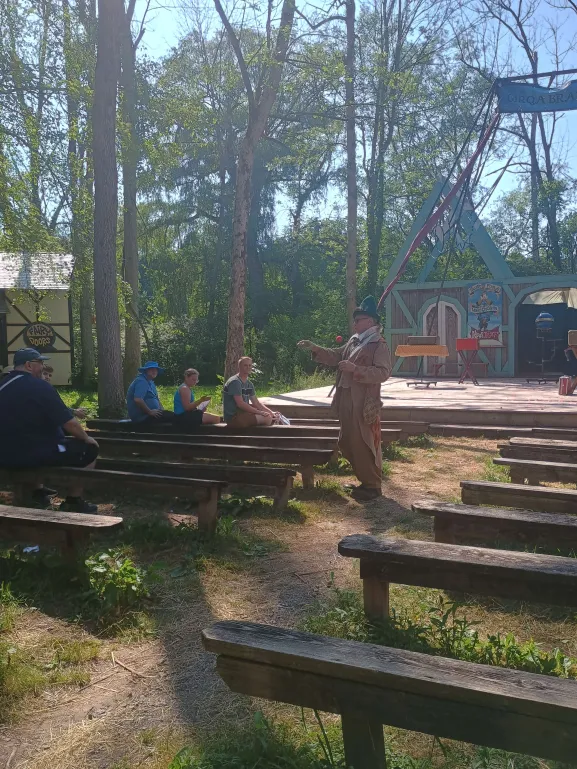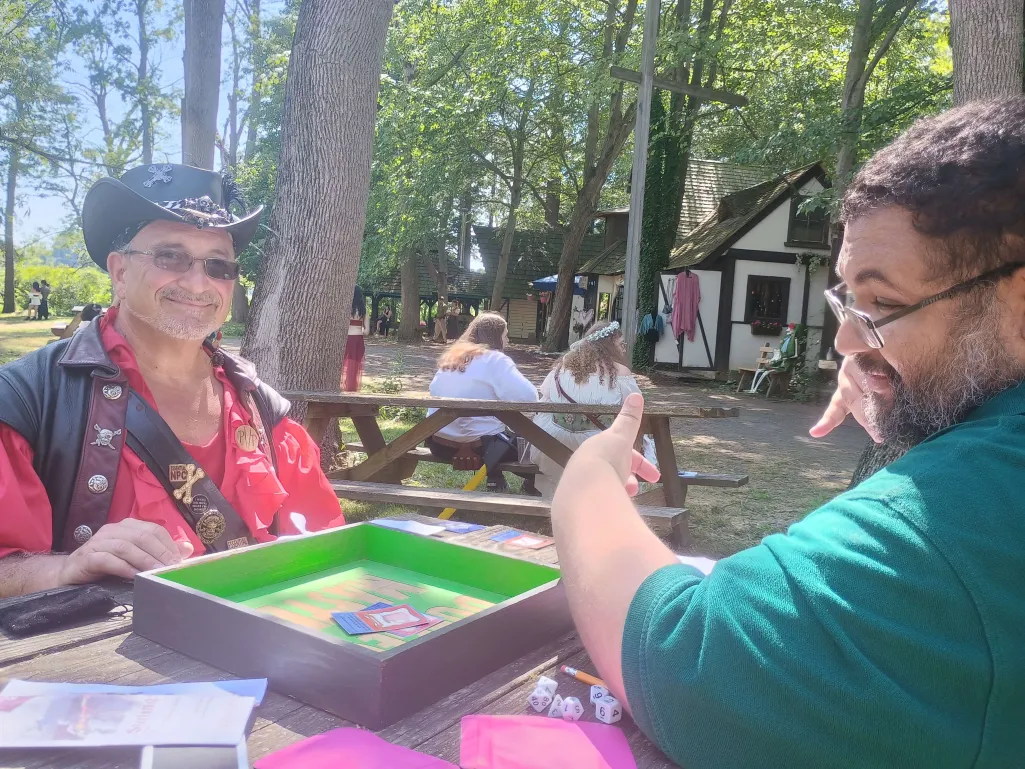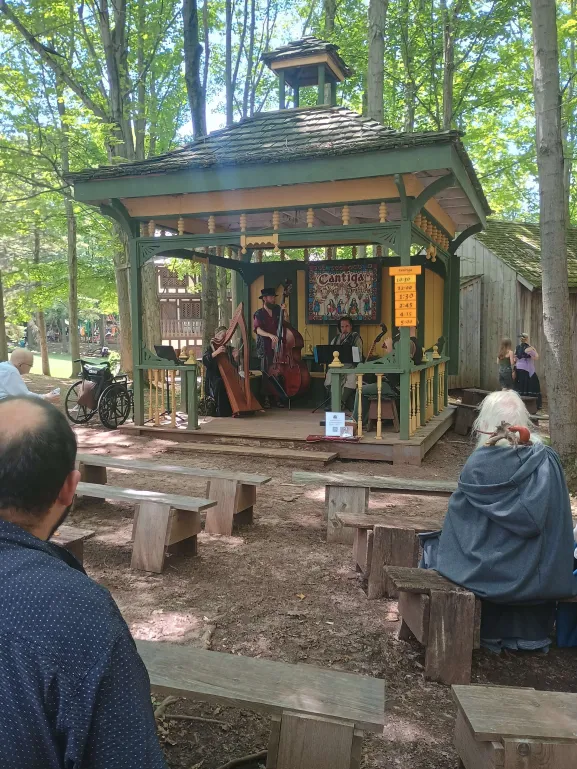RPG in the Wild: My Adventure at Ren Faire with Dragonfly’s Realm

When I visited the Sterling Renaissance Faire, I came across something that felt like stepping directly into one of my tabletop campaigns. Dragonfly’s Realm had set up an RPG that turned the faire itself into the game board.
The character creation process was quick and intuitive: you rolled dice to determine your hit points, your defense score, and a class specific item that determined the size of your weapon’s attack die. With those stats in hand, you were given a small deck of cards filled with classic RPG flavor: healing potions, magical strikes, defensive buffs, and tricksy debuffs.
Once your adventurer was ready, you stepped into the faire as part of the story. Encounters happened organically. Sometimes you challenged another player. Other times you found an NPC or a monster (played by staff or members of the Dragonfly’s Realm Team), each with their own special deck. Combat was handled simply and quickly: roll initiative, roll to hit against their defense, then roll your weapon die for damage. Every duel was fast-paced, exciting, and often surprising.
The best part was how accessible it all was. There were no large rulebooks, no lengthy prep sessions, just dice, cards, imagination, and a few pages set up to guide new players. It struck a perfect balance between the familiar mechanics of a TTRPG and the immediacy of live play.
What made the experience so memorable was how it blurred the line between play and the real world. I wasn’t just carrying a character sheet tucked under my arm. I was inhabiting that character as I strolled through the faire. Every corner of the grounds felt alive with possibility: the chance that the next person I spoke to might not just be a merchant or fellow guest, but a quest-giver or even a monster in disguise.
There was a thrill in that unpredictability. One moment I was chatting casually with someone in costume, the next we were rolling initiative, dice clattering on a wooden bench. I remember how it felt to draw from my hand of cards, weighing whether to spend a healing potion now or risk pressing forward with one last desperate strike. Even though the rules were simple, the tension felt real. Every battle was a tiny story, complete with triumphs, setbacks, and sometimes a dramatic last-minute comeback.
As a librarian and a gamemaster, I couldn’t help but imagine how easily this could be adapted to the library. What if our stacks became the dungeon halls? What if our staff became quest-givers, rivals, or even monsters to face? What if the library itself became an adventuring ground?

Proposal: “Library Quests – A Live RPG in the Stacks”
Overview
“Library Quests” would bring an interactive, roleplaying experience into the library. Using a simple dice-and-card system inspired by Dragonfly’s Realm, teens and patrons could create characters, explore the library, and complete quests by interacting with staff and their environment.
Dragonfly’s Realm game reminded me of something important: roleplaying games are not just about dice and numbers, but about turning the ordinary world into a place of magic. And what better place to do that than the library?
- Character Creation: Participants roll dice for hit points, defense, and weapon strength. Each receives a character sheet and a starting deck of ability/item cards.
- Quests: Players explore the library to complete missions such as:
- Recover the Lost Tome of Forgotten Lore (finding a specific book or call number).
- Defeat the Phantom of the Archives (a staff member roleplaying as a ghostly adversary).
- Solve the Riddle of the Catalog (a puzzle that requires using library tools to find the answer).
- Encounters: Players may duel each other, or challenge staff/NPCs for loot and rewards. Combat is quick, friendly, and resolved with dice and cards.
- Rewards: Successful quests might grant new cards, story tokens, or entry into a larger ongoing narrative.
Why It Works for the Library
- Encourages exploration of the library’s collections and spaces in a fun, low-pressure way.
- Builds teamwork and social skills through cooperative quests.
- Appeals to teens and young adults who may already love fantasy and gaming, giving them a new way to engage with the library.
- Requires minimal materials: dice, cards, and a bit of imagination.
Next Steps for Launching Library Quests
1. Choose a Theme
Pick a simple storyline to tie quests together, such as “The Lost Tome of Forgotten Lore” (fantasy), “The Haunted Archives” (spooky), or “The Great Library Heist” (mystery). Decide if this is a one-time event or the start of a recurring series.
2. Prepare Materials
- Character sheets (HP, Defense, Weapon).
- Starter cards: healing, buffs, items, a few rare rewards.
- Dice (communal sets are fine).
- Quest cards that lead to books, spaces, or staff NPCs.
3. Assign Roles
- Staff or volunteers act as NPCs, quest-givers, or “monsters.”
- One Game Guide oversees play and explains rules.
4. Run the Event
- Start with character creation and a rules overview.
- Let players explore, duel, and complete quests around the library.
- NPCs offer a mix of riddles, dice challenges, or scavenger hunts.
- End with a short group gathering to share stories.
5. Gather Feedback
Ask players what worked, what was confusing, and what they’d like to see next time. Use this to refine mechanics or add variety.
6. Promote and Connect
Advertise with RPG-inspired posters: “Create your hero. Explore the library. Go on a quest.” Pair with book displays (fantasy novels, RPG manuals, comics) to link the adventure to library resources.
7. Keep it Accessible
Offer pre-made characters for new players. Mix challenges so they aren’t all combat-based. Ensure quests can be done by anyone, regardless of physical ability or RPG experience.

